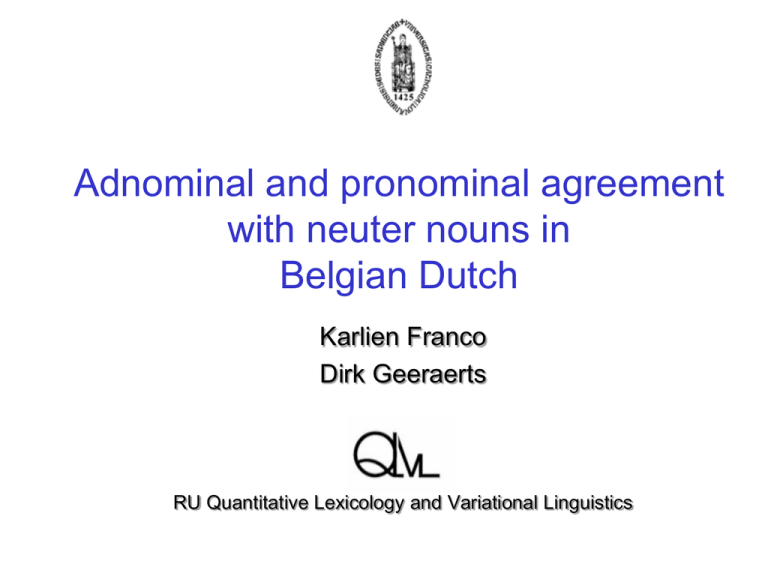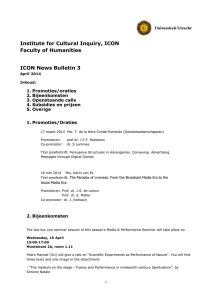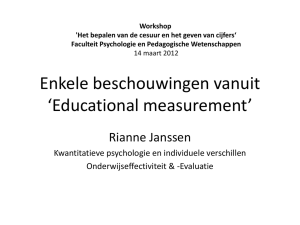
Adnominal and pronominal agreement
with neuter nouns in
Belgian Dutch
Karlien Franco
Dirk Geeraerts
RU Quantitative Lexicology and Variational Linguistics
Overview
• Background
• Methodology
• Results
• Conclusion
Methods in Dialectology XV, Groningen 15.08.2014
Overview
• Background
1. Standard Netherlandic Dutch
2. Standard Belgian Dutch
3. Substandard Belgian Dutch
• Methodology
• Results
• Conclusion
Methods in Dialectology XV, Groningen 15.08.2014
Gender in Standard Netherlandic Dutch
masculine
de
feminine
de
neuter
het
personal
pronoun
hij (‘ie, die)
zij (ze)
het (‘t)
possessive
pronoun
zijn (z’n, ze) haar (‘r, d’r)
definite
article
zijn (z’n, ze)
Methods in Dialectology XV, Groningen 15.08.2014
Gender in Standard Netherlandic Dutch
masculine
de
feminine
de
neuter
het
personal
pronoun
hij (‘ie, die)
zij (ze)
het (‘t)
possessive
pronoun
zijn (z’n, ze) haar (‘r, d’r)
definite
article
zijn (z’n, ze)
Methods in Dialectology XV, Groningen 15.08.2014
Gender in Standard Netherlandic Dutch
• animate referents
Dat
lieve kind,
het
speelt altijd
DEM.N
sweet child(N)
3SG.N
plays
zoo zoet.
always so nicely
‘That sweet child, he/she is always playing so nicely.’
(Royen 1932:158)’
Methods in Dialectology XV, Groningen 15.08.2014
Gender in Standard Netherlandic Dutch
• animate referents: agreement with natural gender
Dat
lieve kind,
het
hij
ze
speelt altijd
DEM.N
sweet child(N)
3SG.N
3SG.M
3SG.F
plays
zoo zoet.
always so nicely
‘That sweet child, he/she is always playing so nicely.’
(Royen 1932:158)’
Methods in Dialectology XV, Groningen 15.08.2014
Gender in Standard Netherlandic Dutch
• animate referents: agreement with natural gender
• inanimate referents:
masculinization
resemanticization
Methods in Dialectology XV, Groningen 15.08.2014
Gender in Standard Netherlandic Dutch
• animate referents: agreement with natural gender
• inanimate referents:
masculinization
De
presentatie,
DEF.C presentation(F)
hij
is
3sg.M is
eindelijk af.
finally
finished
resemanticization
Methods in Dialectology XV, Groningen 15.08.2014
Gender in Standard Netherlandic Dutch
• animate referents: agreement with natural gender
• inanimate referents:
masculinization
De
presentatie, hij
is eindelijk af.
DEF.C presetation(F) 3sg.M is finally
finished
resemanticization (Audring 2006, 2009)
Heb jij een fototoestel?
Have you a
camera(N)
nee ik kan die
no
I
van m’n broer wel lenen.
can DEM.C of
my
brother PRT borrow
Methods in Dialectology XV, Groningen 15.08.2014
Resemanticization
= semantic agreement based on degree of individuation
of antecedent (Audring 2006, 2009):
human
masc./fem.
common
kind
‘child’
other
bounded
specific
unspec. mass/
animate
obj./abs.
mass
unbounded abs.
masc./
common
neuter
fototoestel
olijfolie
‘camera’
‘olive oil’
Methods in Dialectology XV, Groningen 15.08.2014
Overview
• Background
1. Standard Netherlandic Dutch
2. Standard Belgian Dutch
3. Substandard Belgian Dutch
• Methodology
• Results
• Conclusion
Methods in Dialectology XV, Groningen 15.08.2014
Gender in Standard Belgian Dutch
• conservative gender system:
masculinization occurs as well (Geeraerts 1992;
Geerts 1968, 1988)
resemanticization?
Methods in Dialectology XV, Groningen 15.08.2014
Overview
• Background
1. Standard Netherlandic Dutch
2. Standard Belgian Dutch
3. Substandard Belgian Dutch
• Methodology
• Results
• Conclusion
Methods in Dialectology XV, Groningen 15.08.2014
Gender in substandard Belgian Dutch
• three-way flection adnominal elements in dialects
e.g. Brabantic dialects:
masculine
feminine
neuter
indefinite
article
ne vader
nen hoed
een/‘n tante
een aalbees
e bed
een uur
definite article
de vader
den hoed
de tante
d’aalbees
het bed
het uur
(Ooms & Van Keymeulen 2005: 50-53)
Methods in Dialectology XV, Groningen 15.08.2014
Gender in substandard Belgian Dutch
• non-standard gender
Standard Dutch:
het boek
het bureau
substandard Belgian Dutch: den boek
den bureau
Methods in Dialectology XV, Groningen 15.08.2014
Gender in substandard Belgian Dutch
• resemanticization in dialects
• inanimates: large amount of deviations from
grammatical gender are semantically motivated
(but not all of them) (a.o. De Vos & De Vogelaer
2011)
• influence of visibility of gender on adnominal
elements (De Vogelaer & De Sutter 2011)
Methods in Dialectology XV, Groningen 15.08.2014
Gender in substandard Belgian Dutch
• resemanticization in dialects
• inanimates: large amount of deviations from
grammatical gender are semantically motivated
(but not all of them) (a.o. De Vos & De Vogelaer
2011)
• influence of visibility of gender on adnominal
elements (De Vogelaer & De Sutter 2011)
BUT:
• no corpus studies
• no studies on regiolect
Methods in Dialectology XV, Groningen 15.08.2014
Research questions
1. Does the degree of individuation of the antecedent
influence gender in spoken Belgian Dutch?
2. Is the gender of pronouns and determiners governed
by the same system?
Methods in Dialectology XV, Groningen 15.08.2014
Overview
• Background
• Methodology
• Results
• Conclusion
Methods in Dialectology XV, Groningen 15.08.2014
Data
Corpus Gesproken Nederlands (‘corpus of spoken
Dutch’):
a: spontaneous face-to-face conversations
b: interviews with teachers of Dutch
f: interviews and discussions broadcast on radio
and television
h: recordings of lessons
Belgian data only
Methods in Dialectology XV, Groningen 15.08.2014
Data
sentences containing:
• singular neuter noun
• target within span of 5 words left & right
• n = 11262
Methods in Dialectology XV, Groningen 15.08.2014
Data
dependent variable: target gender (common/neuter)
determiners:
definite article
demonstrative determiner
pronouns:
demonstrative pronoun
relative pronoun
Methods in Dialectology XV, Groningen 15.08.2014
Independent variables
•
•
•
•
•
•
word class
semantic class
gender substandard Belgian Dutch
register
distance
speaker information
Methods in Dialectology XV, Groningen 15.08.2014
Independent variables
• word class
•
•
•
•
•
article, dem.det,
dem.pron, rel.pron
semantic class
gender substandard Belgian Dutch
register
distance
speaker information
Methods in Dialectology XV, Groningen 15.08.2014
Independent variables
•
•
•
•
•
•
word class
semantic class
gender substandard Belgian Dutch
register
distance
speaker information
Methods in Dialectology XV, Groningen 15.08.2014
Semantic class
referent
corpus examples
animate
kind (‘child’)
collective
bezoek (‘visitors’), geld (‘money)
concrete count
boek (‘book’),
concrete mass
water (‘water’)
abstract count
budget (‘budget’)
abstract mass
onderwijs (‘education’)
Methods in Dialectology XV, Groningen 15.08.2014
Independent variables
•
•
•
•
•
•
word class
semantic class
gender substandard Belgian Dutch
register
distance
speaker information
Methods in Dialectology XV, Groningen 15.08.2014
Gender in substandard Belgian Dutch
• Nijhoffs Zuid-Nederlands Woordenboek
(‘Nijhoff’s Dictionary of Southern Dutch’, De Clerck
1981)
• explicitly states to provide information about gender
when it differs from Standard Dutch
• common, neuter or unknown
Methods in Dialectology XV, Groningen 15.08.2014
Independent variables
word class
semantic class
gender substandard Belgian Dutch
register
private (face-to-face conversations)
public (interviews & lessons)
• distance
• speaker information
•
•
•
•
Methods in Dialectology XV, Groningen 15.08.2014
Independent variables
•
•
•
•
•
•
word class
semantic class
gender substandard Belgian Dutch
register
distance
speaker information
Methods in Dialectology XV, Groningen 15.08.2014
Distance
number of words between antecedent and target:
near: ≤ 2 words
het
boek
van Star Wars
far: > 2 words
een nichtje van mij die gaat nog trouwen
Methods in Dialectology XV, Groningen 15.08.2014
Independent variables
•
•
•
•
•
•
word class
semantic class
gender substandard Belgian Dutch
register
distance
speaker information
Methods in Dialectology XV, Groningen 15.08.2014
Speaker information
395 speakers
• age:
•
•
•
•
•
between 21 and 81
mean = 43.98
sex:
male, female
region:
antfb, lim, eastf, westf
education level: high, mid_low
occupation level: high, mid_low
first language:
dialect, regiolect, SD, unknown
influence of gender visibility
Methods in Dialectology XV, Groningen 15.08.2014
Analyses
logistic regression
forward stepwise selection
main effects
interaction effects
first model starts from hypothesis that determiners &
pronouns are governed by the same system
overall common gender infrequent: 299/11262
Methods in Dialectology XV, Groningen 15.08.2014
Overview
• Background
• Methodology
• Results
• Conclusion
Methods in Dialectology XV, Groningen 15.08.2014
Analysis full dataset
gender ~
semClass
+ substGender
+ wordClass
+ register
+ sprEduLevel
+ distance
+ sprOccLevel
+ substGender:register
+ substGender:wordClass
+ semClass:register
n = 11262
only 2.56%
common
C = 0.787
Methods in Dialectology XV, Groningen 15.08.2014
Analysis full dataset
gender ~
semClass
+ substGender
+ wordClass
+ register
+ sprEduLevel
+ distance
+ sprOccLevel
+ substGender:register
+ substGender:wordClass
+ semClass:register
n = 11262
only 2.56%
common
C = 0.787
Methods in Dialectology XV, Groningen 15.08.2014
Interaction substandard gender & wordClass
Methods in Dialectology XV, Groningen 15.08.2014
Interaction substandard gender & wordClass
Methods in Dialectology XV, Groningen 15.08.2014
Determiners versus pronouns
determiners
pronouns
semantic class
education level
substandard gender
register
occupation level
substandard gender:register
semantic class
education level
region
(word class)
semantic class:word class
word class:education level
Methods in Dialectology XV, Groningen 15.08.2014
Determiners versus pronouns
determiners
pronouns
semantic class
education level
substandard gender
register
occupation level
substandard gender:register
semantic class
education level
region
(word class)
semantic class:word class
word class:education level
Methods in Dialectology XV, Groningen 15.08.2014
Determiners versus pronouns
determiners
pronouns
semantic class
education level
substandard gender
register
occupation level
substandard gender:register
semantic class
education level
region
(word class)
semantic class:word class
word class:education level
Methods in Dialectology XV, Groningen 15.08.2014
Determiners versus pronouns
determiners
pronouns
semantic class
education level
substandard gender
register
occupation level
substandard gender:register
semantic class
education level
region
(word class)
semantic class:word class
word class:education level
Methods in Dialectology XV, Groningen 15.08.2014
Analysis determiners
variables
estimate
p-value
(Intercept)
-1.5340
<0.01
substGender neuter
-3.6050
<0.001
substGender unknown
-2.7533
<0.001
semClass collective
-0.7205
not sign
semClass conc+count+
0.4069
not sign
semClass conc+count-
1.7220
<0.01
semClass conc-count+
-0.4326
not sign
semClass conc-count-
0.9160
<0.1
-2.3325
<0.001
sprEduLevel mid_low
1.8654
<0.05
sprOccLevel mid_low
0.4728
<0.01
distance far
0.8563
<0.1
substGender neuter:register public
1.9105
<0.01
substGender unknown:register public
1.9254
<0.001
-1.4121
<0.1
register public
sprEduLevel mid_low:sprOccLevel mid_low
n = 10179
only 2.16%
common
C = 0.756
Estimate
+ sign: more
common gender
- sign: less common
gender
Methods in Dialectology XV, Groningen 15.08.2014
Analysis determiners
variables
estimate
p-value
(Intercept)
-1.5340
<0.01
substGender neuter
-3.6050
<0.001
substGender unknown
-2.7533
<0.001
semClass collective
-0.7205
not sign
semClass conc+count+
0.4069
not sign
semClass conc+count-
1.7220
<0.01
semClass conc-count+
-0.4326
not sign
semClass conc-count-
0.9160
<0.1
-2.3325
<0.001
sprEduLevel mid_low
1.8654
<0.05
sprOccLevel mid_low
0.4728
<0.01
distance far
0.8563
<0.1
substGender neuter:register public
1.9105
<0.01
substGender unknown:register public
1.9254
<0.001
-1.4121
<0.1
register public
sprEduLevel mid_low:sprOccLevel mid_low
• gender in
substandard
Belgian Dutch
highly significant
• effect
neutralized in
public
conversations
Methods in Dialectology XV, Groningen 15.08.2014
Analysis determiners
variables
estimate
p-value
(Intercept)
-1.5340
<0.01
substGender neuter
-3.6050
<0.001
substGender unknown
-2.7533
<0.001
semClass collective
-0.7205
not sign
semClass conc+count+
0.4069
not sign
semClass conc+count-
1.7220
<0.01
semClass conc-count+
-0.4326
not sign
semClass conc-count-
0.9160
<0.1
-2.3325
<0.001
sprEduLevel mid_low
1.8654
<0.05
sprOccLevel mid_low
0.4728
<0.01
distance far
0.8563
<0.1
substGender neuter:register public
1.9105
<0.01
substGender unknown:register public
1.9254
<0.001
-1.4121
<0.1
register public
sprEduLevel mid_low:sprOccLevel mid_low
degree of
individuation not
important
Methods in Dialectology XV, Groningen 15.08.2014
Analysis determiners
variables
estimate
p-value
(Intercept)
-1.5340
<0.01
substGender neuter
-3.6050
<0.001
substGender unknown
-2.7533
<0.001
semClass collective
-0.7205
not sign
semClass conc+count+
0.4069
not sign
semClass conc+count-
1.7220
<0.01
semClass conc-count+
-0.4326
not sign
semClass conc-count-
0.9160
<0.1
-2.3325
<0.001
sprEduLevel mid_low
1.8654
<0.05
sprOccLevel mid_low
0.4728
<0.01
distance far
0.8563
<0.1
substGender neuter:register public
1.9105
<0.01
substGender unknown:register public
1.9254
<0.001
-1.4121
<0.1
register public
sprEduLevel mid_low:sprOccLevel mid_low
influence lower
level of education
or occupation
Methods in Dialectology XV, Groningen 15.08.2014
Determiners versus pronouns
determiners
pronouns
semantic class
education level
substandard gender
register
occupation level
substandard gender:register
semantic class
education level
region
(word class)
semantic class:word class
word class:education level
Methods in Dialectology XV, Groningen 15.08.2014
Analysis pronouns
variables
estimate
p-value
(Intercept)
-1.2439
<0.01
semClass collective
-2.1188
<0.01
semClass inanimate
-3.9440
<0.001
wordClass rel.pron
0.3288
not sign
sprRegion wfl
-0.1360
not sign
sprRegion lim
0.5643
not sign
sprRegion eastf
0.7267
<0.05
sprEduLevel mid_low
2.2078
<0.01
semClass collective:wordClass rel.pron
0.8119
not sign
semClass inanimate:wordClass rel.pron
1.9834
<0.01
wordClass rel.pron:sprEduLevel mid_low
-1.6562
<0.5
n = 1083
only 7.76%
common
C = 0.837
Estimate
+ sign: more
common gender
- sign: less common
gender
Methods in Dialectology XV, Groningen 15.08.2014
Analysis pronouns
variables
estimate
p-value
(Intercept)
-1.2439
<0.01
semClass collective
-2.1188
<0.01
semClass inanimate
-3.9440
<0.001
wordClass rel.pron
0.3288
not sign
sprRegion wfl
-0.1360
not sign
sprRegion lim
0.5643
not sign
sprRegion eastf
0.7267
<0.05
sprEduLevel mid_low
2.2078
<0.01
semClass collective:wordClass rel.pron
0.8119
not sign
semClass inanimate:wordClass rel.pron
1.9834
<0.01
wordClass rel.pron:sprEduLevel mid_low
-1.6562
<0.5
• degree of
individuation
• random variation
relative
pronouns
Methods in Dialectology XV, Groningen 15.08.2014
Analysis pronouns
variables
estimate
p-value
(Intercept)
-1.2439
<0.01
semClass collective
-2.1188
<0.01
semClass inanimate
-3.9440
<0.001
wordClass rel.pron
0.3288
not sign
sprRegion wfl
-0.1360
not sign
sprRegion lim
0.5643
not sign
sprRegion eastf
0.7267
<0.05
sprEduLevel mid_low
2.2078
<0.01
semClass collective:wordClass rel.pron
0.8119
not sign
semClass inanimate:wordClass rel.pron
1.9834
<0.01
wordClass rel.pron:sprEduLevel mid_low
-1.6562
<0.5
• more common
gender in East
Flanders
Methods in Dialectology XV, Groningen 15.08.2014
Analysis pronouns
variables
estimate
p-value
(Intercept)
-1.2439
<0.01
semClass collective
-2.1188
<0.01
semClass inanimate
-3.9440
<0.001
wordClass rel.pron
0.3288
not sign
sprRegion wfl
-0.1360
not sign
sprRegion lim
0.5643
not sign
sprRegion eastf
0.7267
<0.05
sprEduLevel mid_low
2.2078
<0.01
semClass collective:wordClass rel.pron
0.8119
not sign
semClass inanimate:wordClass rel.pron
1.9834
<0.01
wordClass rel.pron:sprEduLevel mid_low
-1.6562
<0.5
• more common
gender in East
Flanders
• influence lower
education level
• effect larger for
demonstrative
pronouns
Methods in Dialectology XV, Groningen 15.08.2014
Analysis pronouns
variables
estimate
p-value
(Intercept)
-1.2439
<0.01
semClass collective
-2.1188
<0.01
semClass inanimate
-3.9440
<0.001
wordClass rel.pron
0.3288
not sign
sprRegion wfl
-0.1360
not sign
sprRegion lim
0.5643
not sign
sprRegion eastf
0.7267
<0.05
sprEduLevel mid_low
2.2078
<0.01
semClass collective:wordClass rel.pron
0.8119
not sign
semClass inanimate:wordClass rel.pron
1.9834
<0.01
wordClass rel.pron:sprEduLevel mid_low
-1.6562
<0.5
• more common
gender in East
Flanders
• influence lower
education level
• effect larger for
demonstrative
pronouns
no interaction with
semantic class
Methods in Dialectology XV, Groningen 15.08.2014
Overview
• Background
• Methodology
• Results
• Conclusion
Methods in Dialectology XV, Groningen 15.08.2014
Conclusion
different mechanisms:
• common gender definite articles & determiners:
grammatical agreement with substandard gender
• common gender demonstrative & relative pronouns:
semantic agreement with referential properties of
antecedent
Methods in Dialectology XV, Groningen 15.08.2014
Conclusion
different mechanisms:
only in private
conversations
• common gender definite articles & determiners:
grammatical agreement with substandard gender
• common gender demonstrative & relative pronouns:
semantic agreement with referential properties of
antecedent
Methods in Dialectology XV, Groningen 15.08.2014
Conclusion
different mechanisms:
only in private
conversations
• common gender definite articles & determiners:
grammatical agreement with substandard gender
• common gender demonstrative & relative pronouns:
semantic agreement with referential properties of
antecedent
random variation
Methods in Dialectology XV, Groningen 15.08.2014
for further information:
karlien.franco@kuleuven.be
http://wwwling.arts.kuleuven.be/qlvl
References
ANS = Geerts, G., Haeseryn, W & De Rooij, J. (reds.). (1997). Algemene
Nederlandse spraakkunst. Deurne: Wolters Plantyn/Groningen: Martinus Nijhoff.
Audring, J. 2006. Pronominal gender in spoken Dutch. Journal of Germanic
Linguistics 8(2). 85-116.
Audring, J. 2009. Reinventing Pronoun Gender. Utrecht: LOT.
Booij, G.E. 2002. The Morphology of Dutch. Oxford/New York: Oxford University
Press.
Corbett, G.G. 1979. The agreement hierarchy. Journal of Linguistics 15(2). 203-224.
De Vogelaer, G. 2009. Changing pronominal gender in Dutch. Transmission or
diffusion? In Tsiplakou, S., Karyolemou, M. & Pavlou, P. (eds.). Language Variation
- European Perspectives II, 71-80. Amsterdam/Philadelphia: John Benjamins.
De Vos, L. & De Vogelaer, G. 2011. Dutch gender and the locus of morphological
regularization. Folia Linguistica 45(2). 245-281.
Geeraerts, D. 1992. Pronominale-masculiniseringsparameters in Vlaanderen. In
Bennis, H. & De Vries, J.W. (eds.). De binnenbouw van het Nederlands: een
bundel artikelen voor Piet Paardekooper, 73-84. Dordrecht: ICG Publications.
Methods in Dialectology XV, Groningen 15.08.2014
References
Geerts, G. 1966. Genus en geslacht in de Gouden Eeuw. Een bijdrage tot de studie
van de nominale klassifikatie en daarmee samenhangende adnominale
flexievormen en pronominale verschijnselen in Hollands taalgebruik van de
zeventiende eeuw. Brussels: Belgisch Interuniversitair Centrum voor Neerlandistiek.
Geerts, G. 1968. Hij geeft melk. Dietsche Warande en Belfort 113. 50-60.
Geerts, G. 1988. Genusfouten: Hollanditis in Vlaanderen? Verslagen en
Mededelingen van de Koninklijke Academie voor Nederlandse Taal- en
Letterkunde 1. 68-78.
Ooms, M. & Van Keymeulen, J. 2005. Taal in stad en land. Vlaams-Brabants en
Antwerps. Tielt: Lannoo.
De Vos, L. & De Vogelaer, G. 2011. Dutch gender and the locus of morphological
regularization. Folia Linguistica 45(2). 245-281.
Semplicini, C. 2012. Dutch double gender nouns: arbitrary or motivated
agreement? Journal of Germanic Linguistics 24(2). 133-186.
Van Haeringen, C.B. 1951. Genusverandering bij stofnamen. De Nieuwe Taalgids
44. 7- 14.
Methods in Dialectology XV, Groningen 15.08.2014


